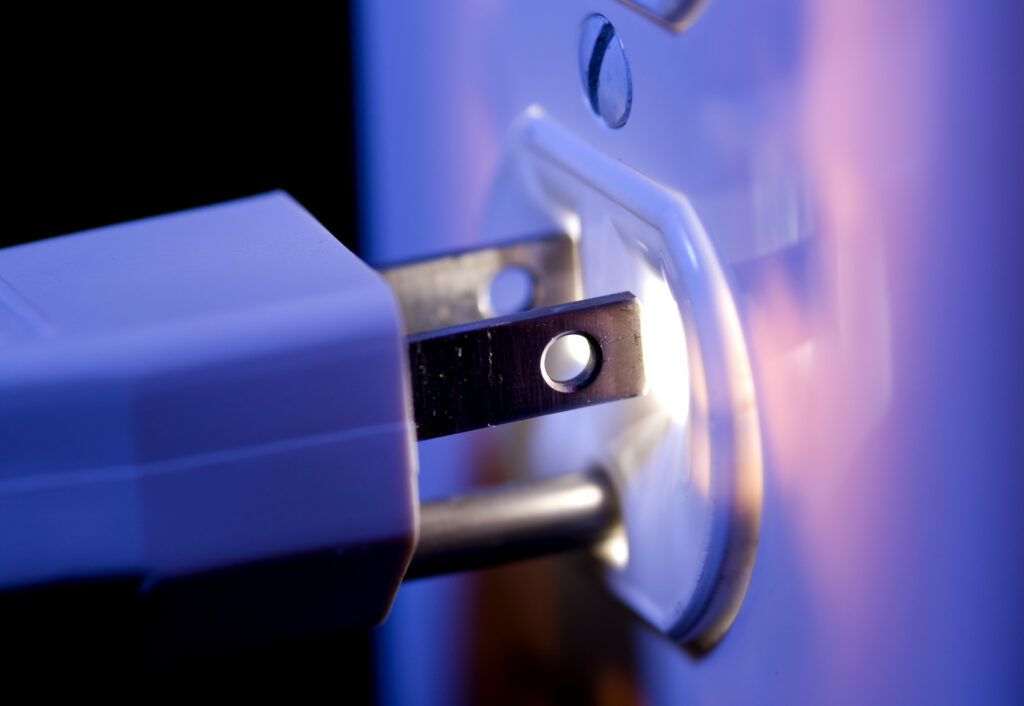
If you’ve ever noticed that an outlet only has two prongs instead of three, you may be wondering what the difference is and whether that outlet is safe. The third prong on a three-prong outlet is the ground, which protects you from electrical shock by redirecting excess electricity into the ground. Many older homes still have two-prong outlets that lack this grounding protection. Fortunately, there are solutions, but not all are DIY appropriate.
In this blog post, the expert electricians at Universe Home Services explore the basics of grounding two-prong and three-prong outlets and when it’s best to call a professional.
How to Tell if an Outlet is Grounded
Before making any changes to your outlets, it’s important to determine whether your outlet is already grounded. Here are a few ways to check:
- Use a circuit tester: You can buy a simple outlet tester at a hardware store, plug it into the outlet, and monitor the lights to indicate whether the outlet is properly grounded.
- Look inside the box: Turn off the power to the outlet at the breaker, unscrew the faceplate, and pull the outlet out gently. If you see a bare copper or green wire connected to a screw on the outlet or metal box, the outlet may be grounded.
- Check for a grounding path: If the outlet is installed in a metal box and that box is grounded, the outlet may be grounded via the box, but you’ll need to test for continuity to be sure.
How to Ground an Outlet with Only Two Wires
If your outlet has only two wires, it likely isn’t grounded. Here’s what you can do to ground it properly:
Install a GFCI Outlet
The most common way to upgrade a two-prong outlet without adding a ground wire is to install a ground fault circuit interrupter (GFCI). These outlets monitor current flow and shut off power if there’s a fault, offering protection even without a ground wire. Be sure to use the supplied “No Equipment Ground” label on the outlet faceplate to meet code requirements. This doesn’t create a ground, but it’s code-compliant in many jurisdictions for upgrading safety.
Use a Metal Outlet Box
If the outlet is housed in a grounded metal box and the conduit is grounded, you may be able to ground the new outlet by connecting the ground terminal on the outlet to the box using a short grounding wire (pigtail).
Run a Ground Wire
Run a dedicated ground wire back to the main panel or a properly grounded circuit for a true grounding solution. A licensed electrician is often best able to handle this option.
How to Ground a Three-Prong Outlet
If your outlet has three slots, but you suspect it’s not grounded, it may have been installed improperly. Here’s how to ground it safely:
- Test the outlet: Use an outlet tester to confirm whether it’s actually grounded. Some older homes have three-prong outlets without a real ground.
- Ground to metal box: If the metal box is grounded, connect a grounding pigtail from the green screw on the outlet to the box.
- Add a ground wire: If there’s no grounding path, you’ll need to run a copper ground wire from the outlet back to your breaker panel or another grounded outlet or box.
Warning: Replacing a two-prong outlet with a three-prong outlet without proper grounding is not code-compliant and can be dangerous.
When to Call a Professional Electrician
Call a licensed electrician if you’re ever unsure about your home’s wiring or don’t have experience working with electricity. Improper grounding can pose serious safety risks. A professional will test and verify ground paths, safely upgrade your outlets, and ensure your home is up to code.
Why Choose Us?
Universe Home Services is your trusted local team for safe, code-compliant electrical upgrades. Whether you need to ground a single outlet or rewire multiple circuits, our team offers the fast, friendly solutions you need, backed by an unwavering commitment to complete satisfaction with every job.
Don’t leave your safety up to chance — schedule electrical services with Universe Home Services today.